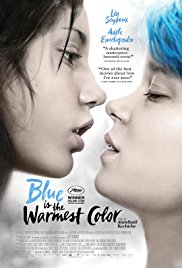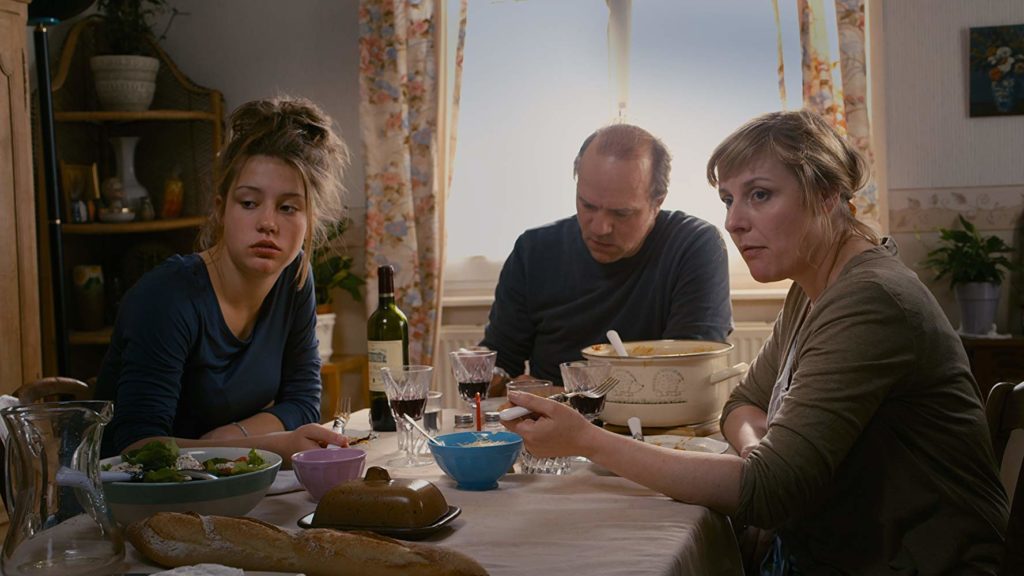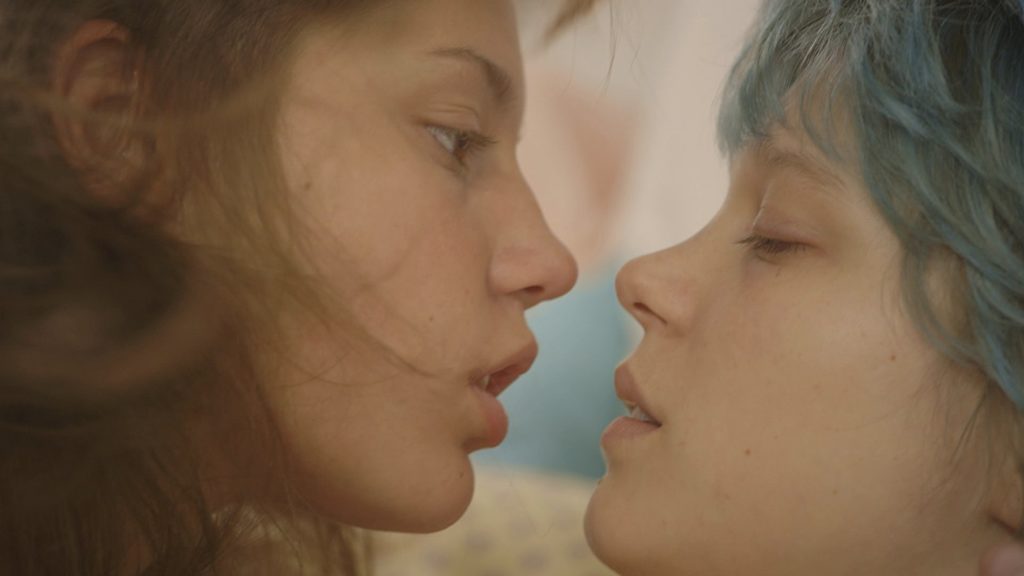Noteworthy Three Hour French Drama Pushes Buttons
DIRECTED BY ABDELLATIF KECHICHE/FRENCH/2013
 Now this is French…! At least, it’s what many may think of when they consider the perceived hallmarks of French cinema: Unfettered in both length and content, not afraid to keep you there longer than you may care to be, and unabashed in its portrayals of physical intimacy (perhaps with more than a hint of masochism, thank you very much Jean-Luc Godard and company). But, make no mistake; Blue is the Warmest Color is not your typical critically adorned foreign hot-button drama. Yes, it runs for three full hours, and yes, it features the most protracted scenes of lesbian sex to adorn cinema screens in a while. (If you’ve heard about this film at all, you’ve already heard about them.) And yes, it won the top prize at the 2013 Cannes Film Festival, awarded by a jury led by Steven Spielberg, no less. (Oh mon, Mr. Spielberg!) But dare I say, this epic length NC-17 outing has earned its acclaim… and its controversy.
Now this is French…! At least, it’s what many may think of when they consider the perceived hallmarks of French cinema: Unfettered in both length and content, not afraid to keep you there longer than you may care to be, and unabashed in its portrayals of physical intimacy (perhaps with more than a hint of masochism, thank you very much Jean-Luc Godard and company). But, make no mistake; Blue is the Warmest Color is not your typical critically adorned foreign hot-button drama. Yes, it runs for three full hours, and yes, it features the most protracted scenes of lesbian sex to adorn cinema screens in a while. (If you’ve heard about this film at all, you’ve already heard about them.) And yes, it won the top prize at the 2013 Cannes Film Festival, awarded by a jury led by Steven Spielberg, no less. (Oh mon, Mr. Spielberg!) But dare I say, this epic length NC-17 outing has earned its acclaim… and its controversy.
The film, for all its international notoriety, is really just a decompressed coming of age tale of a young French girl named Adèle (Adèle Exarchopoulos). There is nothing inherently sexy in a girl coming of age, and the film knows that, although Adèle, like many, will certainly have her moments. We meet her as she nears the end of her high school years. She smokes casually, hangs out a lot with gossipy friends, and wants to be attractive to boys, but, like so many young people, is ironically clearly defined by her lack of self-definition. Adèle is pretty yet a little homely, well dressed but not stylish, and nonchalantly noncommittal in all things, especially her love life. She’s “just a girl”, but over the course of the film’s 179 minutes, this French everygirl somehow becomes one of the years most memorable movie characters. And all she does is grow up.

Adèle meets Emma (Léa Seydoux), a blue haired fine arts student with a carnal glint in her eye. Emma, nearing the end of her college years, has a far more rooted sense of self – one that will only solidify even as the blue hair and glint eventually go away. On the whole, as a character, she proves even more unforgettable. Despite their immediate and undeniable attraction to one another, Adèle and Emma remain opposites in most every way. Tastes in food, culture, family life, and yes, commitment to ones own self are ever in stark contrast. Emma knows herself and knows what she wants out of life. Adèle drifts into a life as a schoolteacher for lack of any true career passion. Even her sexual identity is fluid. When the two get together, it’s electric. When they drift, it’s wrenching for anyone who’s ever been in love.
In its focused (and successful) portrayal of the milieu of contemporary youth culture, the film itself commits 100%. Tunisian born/French raised director Abdellatif Kechiche (The Secret of the Grain) holds back almost nothing in terms of depicting their physical intimacy, which occurs in the course of at least three protracted scenes. In many accounts, these love scenes are improperly referred to as a singular scene that runs sevens minutes. While this reviewer failed to time the scenes in question, the uncommon audience response during the screening did coincide with our own culturally wired timeframe for how long on-screen lovemaking should last. After about a minute, audience chairs started shifting, self-aware chattering picked up, and a number of people just left.

That so much is made of such a small portion of such a very long film is irritating yet very understandable. Would Blue is the Warmest Color (perhaps the most highfalutin graphic novel adaptation since Persepolis) work as well as it does if the controversial sex scenes were absent, or at least of common length? That’s a bit like asking if The Beatles would’ve been as brilliant in their later work if they hadn’t been experimenting with drugs – We of course can’t rightly say. We can only speculate. My speculation is this: While the scenes do go on too long, and are indeed a heterosexual male director’s unhinged depiction of what young lesbian lovemaking might ideally look like, they do not lessen the impact of the film’s relational wallop. They don’t need to be there, not in this manner – particularly in comparison to the considerably smaller amounts of time Kechiche spends on other important details elsewhere within the film.
More troubling is Kechiche’s admission that he shot the sex scenes to deliberately emulate the appeal of lush fine art, perfectly lit and posed[1]. Aside from these scenes and few others, the director displays two preferred shot choices throughout: close-up, and extreme close-up. It’s a naked, wallowing inconsistency: While the rest of Blue oozes with utter naturalism of life in all its tightly framed ugliness and mundane qualities (the irritating clear line of snot dripping from Adèle’s nose whenever she cries seemingly remains on her lip longer than seven minutes. Someone get this girl a tissue already!!), the fact that the sex scenes are the only moments of artifice (denounced by the graphic novel’s author and to some degree, the actresses themselves, as well as many a lesbian viewer) cannot be ignored.

But while even Kechiche, for his own reasons, has stated a desire that the film not be released, [2] his graphic content did not strike me as filthy and degenerate the way Steve McQueen’s did (by design) in Shame, a previous recent major NC-17 release. Shame, for all its strong points, is a case of a film becoming that which it sets out to condemn. Blue isn’t out to condemn anything, just to reflect life in all its beautiful ups and downs. The idealized moments of sexual euphoria are but a blip in the film’s ultimate running time, elsewise full of humdrum scenes in classrooms, a family eating spaghetti with the TV on, chats about books, people walking around, et cetera. Such is life, if you’re doing it right. And maybe, just maybe, that’s what Kechiche is trying to communicate? In any case, I’m personally able to forgive Kechiche his momentary overpowering indulgences on the great strengths of the remaining 172 minutes of Blue is the Warmest Color. Many may not be.
The absolute obsession over the sex in the film points to a certain human truth that our culture of non-commitment has worked hard to get away from: The idea that sex matters. Misuse it, and you or someone you care about is bound to get hurt. We see it all throughout the experience of Blue is the Warmest Color, both on and off screen. In the film, a lackadaisical approach to physical intimacy always cultivates pain. In the making of the film, the fact that the actresses feel they were mistreated while filming indicates a betrayal with their director. (One can wonder what the late Roger Ebert, who gave a famously negative review to David Lynch’s Blue Velvet for similar reasons, would feel about this film.) In the cinema viewing, the fact that audience members have a difficult time with it is telling that here in late 2013, some ingrained notions of virtue and privacy yet remain.
And finally, when an otherwise remarkable three-hour film is absolutely defined by a few scenes that make up a fraction of the overall experience, we can clearly see that somewhere in us, a commitment to honesty in sex still very much matters. And that’s not just French, it’s universal.
[1] Why ‘Blue Is The Warmest Color’ Fails At Showing Lesbian Love policymic.com, November 6, 2013. http://www.policymic.com/articles/72245/why-blue-is-the-warmest-color-fails-at-showing-lesbian-love
[2] ‘Blue Is The Warmest Color’ Director Says The Film Shouldn’t Be Released indiewire.com, September 24, 2013. http://blogs.indiewire.com/theplaylist/blue-is-the-warmest-color-director-says-the-film-shouldnt-be-released-he-thought-of-replacing-lea-seydoux-20130924

